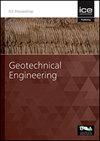用板载试验估算工作平台材料的内摩擦角
IF 1.7
4区 工程技术
Q3 ENGINEERING, GEOLOGICAL
Proceedings of the Institution of Civil Engineers-Geotechnical Engineering
Pub Date : 2023-06-07
DOI:10.1680/jgeen.22.00248
引用次数: 0
摘要
本文回顾了在颗粒土和工作平台材料上进行的499次不同直径的板荷载试验的荷载-沉降行为,以确定试验所调动的内摩擦角。在相对较小的沉降下,单个板荷载试验中观察到的沉降已被外推到板在板直径的10%和15%处的理论破坏(D)。对于每个试验,根据与引起板直径0.10或0.15倍沉降所需的应力相关的承载阻力,计算出有效的内剪切阻力角。研究结果与在工作平台和浅基础中使用高摩擦材料的讨论一起提出。内抗剪有效角的特征值提供给所有测试的工作平台材料,以及对含有碎砖和混凝土的平台材料进行的测试。这些数值与类似材料的剪切箱试验结果进行了比较。计算了破碎砖和混凝土材料的φ在44°至46.4°(0.1D)和45.3°至47.8°(0.15D)之间的特征值,略高于1型材料的试验结果。本文章由计算机程序翻译,如有差异,请以英文原文为准。
Estimation of internal friction angle for working platform materials by plate load test
This paper reviews the load-settlement behaviour of 499 plate load tests of various diameters undertaken on granular soils and working platform materials to determine the angle of internal friction mobilised by the test. The observed settlement of individual plate load tests at relatively small settlement has been extrapolated to a theoretical failure of the plate at 10% and 15% of the plate's diameter (D). For each test an effective angle of internal shearing resistance was calculated based on the bearing resistance associated with the stress required to cause settlement of 0.10 or 0.15 times the plate diameter. The results are presented along with a discussion on the use of high friction materials in working platforms and shallow foundations. Characteristic values for the effective angle of internal shearing resistance are provided for all working platform materials tested as well as tests undertaken on platform materials comprising crushed brick and concrete. These values are compared to shear box test results on similar materials. Characteristic values of ϕ’ varying from 44° to 46.4° (0.1D) and 45.3° to 47.8° (0.15D) for crushed brick and concrete materials are calculated, which is slightly higher than that determined from tests on Type 1 material.
求助全文
通过发布文献求助,成功后即可免费获取论文全文。
去求助
来源期刊
CiteScore
4.40
自引率
4.50%
发文量
68
审稿时长
3 months
期刊介绍:
Geotechnical Engineering provides a forum for the publication of high quality, topical and relevant technical papers covering all aspects of geotechnical research, design, construction and performance. The journal aims to be of interest to those civil, structural or geotechnical engineering practitioners wishing to develop a greater understanding of the influence of geotechnics on the built environment.

 求助内容:
求助内容: 应助结果提醒方式:
应助结果提醒方式:


